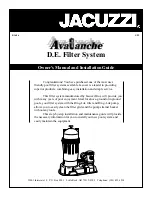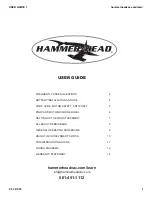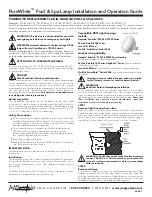
36
gized by a 120 VAC signal from S-1 on the ignition
module for approximately 30 seconds. (The hot
surface igniter must draw greater than 3.1 amps
while being energized or ignition lockout will occur
after three tries.)
43. Once the ignition module determines that the hot
surface igniter has heated up and operating prop-
erly, a 24 VAC signal is output from pin GV on the
module.
44. 24 VAC signal is received at gas valve 1 thus ener-
gizing it.
45. The stage 1 LED on the status display board is
now illuminated.
46. The coil of relay K-2 is now energized with the
N.O. contacts closing downstream of the stage 2
and stage 3 connections.
47. The gas coming through the burners should ignite
from the heat of the hot surface igniter and the
flame should carry over from one burner to the
other burners of stage 1. The remote sensor is
now trying to sense the flame. If the flame is not
sensed within 4 seconds, the ignition module will
shut down gas valve 1 and retry the hot surface
igniter. During ignition retry, the heater must per-
form a 15-second pre-purge and an approximately
30-second igniter warm-up before opening gas
valve 1 again. The standard ignition module will
attempt ignition a maximum of three times prior to
ignition lockout.
48. If the ignition module locks out, a signal will be
sent to the Universal Diagnostics Board to indicate
an ignition fault.
49. When power is sent to gas valve 1 it is also sent to
time delay relay 1 (TD-1) which starts a 5-second
countdown.
50. After the 5-second countdown from TD-1, 24 VAC
is waiting at pin 3 of the stage 2 connections on
the CPW board.
51. After closure of the stage 2 contacts Gas valve 2
is energized.
52. The stage 2 LED on the status display board is
now illuminated.
53. Power is applied to pin 5 of the stage 3 connec-
tions on the CPW board.
54. After closure of the stage 3 contacts, power is
applied to TD-2.
55. After a 5 second countdown TD-2 contacts close.
56. Gas valve 3 then receives 24 VAC and is ener-
gized.
57. The stage 3 LED on the status display board is
now illuminated (end of sequence for 992B).
58. Power is applied to pin 7 of the stage 4 connec-
tions on the CPW board.
59. After closure of the stage 4 contacts, power is
applied to TD-3 (1262B only).
60. After a 5-second countdown TD-3 contacts close.
61. Gas valve 4 (solenoid valve located in the front air
plenum) then receives 24 VAC and is energized.
62. The stage 4 LED on the status display board is
now illuminated.
63. The heater is now operating at full fire.
Models 1532B – 1802B
1.
The black (hot) wire lead goes directly to the main
power switch. This black toggle switch is located
at the middle front of the control compartment.
2.
When the main power switch is placed in the “ON”
position, 120 VAC is applied to the 120 VAC termi-
nal block on the circuit board and the 120/24 VAC
transformer is powered.
3.
120 VAC is waiting at the N.O. contacts of the
Economaster II pump delay.
4.
Terminals L1 and F1 of the ignition module are
powered with 120VAC.
5.
120 VAC power is also applied to the control
power connector on the circuit board.
6.
120 VAC power is waiting at the N.O. contacts of
K-3 relay to energize the heater blowers.
7.
The 120/24 VAC transformer outputs 24 VAC.
8.
24 VAC is sent to pin L1 of the low water cut-off
(optional) and the red power light is energized.
















































